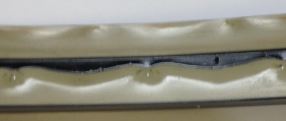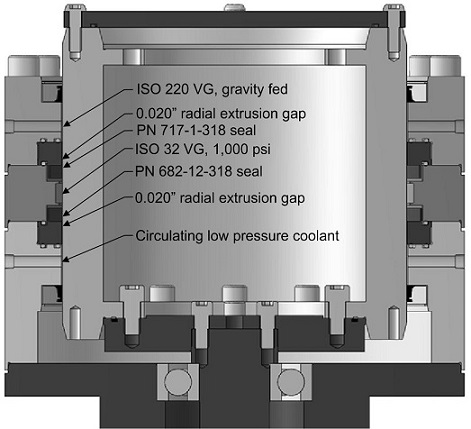Overview
Kalsi Engineering has developed a hydrodynamically lubricated rotary seal that can operate with up to 1,000 psi (6.89 MPa) differential pressure acting from either side of the seal. This new seal, known as the BDRP™ (Bi-Directional Rotation and Pressure), also operates in both directions of rotation. The ability to handle bidirectional pressure and bidirectional rotation makes it a candidate for use as a hydraulic swivel seal.
As with the KLS® Seal, when a BDRP is used with high pressure abrasive fluids, an outboard barrier seal is required, with the region between the seals being balanced to the pressure of the abrasive fluid. As with all Kalsi-brand rotary shaft seals, one side of the BDRP has hydrodynamic waves that must be exposed to a seal lubricant.
The BDRP is a direct-compression high pressure shaft seal design that utilizes composite plastic and elastomer construction. The waves of the BDRP Seal™ are configured to resist pressure-related deformation, in order to provide interfacial lubrication when the pressure of the lubricant is lower than the pressure of the media being sealed.
Reporting on the most recent test
The most recent test of the BDRP Seal was performed at 170 rpm (466 sfpm) and 1,000 psi (6.89 MPa) with a 10.49” (266.45mm) diameter PN 717-1-318 seal. The test was conducted in a fixture designed to test seals for rotary control devices (RCDs). The general test setup is shown below.
The PN 717-1-318 test seal was installed in the upper seal carrier, and a PN 682-12-318 seal was installed in the lower seal carrier. Both seal carriers are fixed, non-floating seal carriers that define a 0.020” (0.51mm) radial extrusion gap clearance. The dynamic runout of the mandrel was 0.007” (0.18mm) at the upper seal, and 0.003” (0.08mm) at the lower seal.
The hydrodynamic waves of both rotary seals faced upward. The lubricant for the PN 717-1-318 test seal was an unpressurized ISO 220 viscosity grade lubricant that was fed to the upper side of the seal by gravity. The 1,000 psi (6.89 MPa) pressure was applied to the lower side of the test seal via an ISO 32 viscosity grade lubricant, which also served as the seal lubricant for the lower rotary seal, PN 682-12-318. The purpose of the lower rotary seal was to retain the 1,000 psi (6.89 MPa) pressure.
In an RCD, the lower end of the mandrel is exposed to circulating drilling fluid. This was simulated by circulating a coolant below the lower seal at about 2 gpm. This was the only circulation provided during the test. The temperature of the coolant was typically about 111 to 119°F (43.9 to 48.3°C). This circulation created a thermal environment for the upper rotary seal that is similar to an RCD without bearing lubricant circulation. The temperature between the rotary seals ranged from about 152 to 170°F (66.7 to 76.7°C), and the temperature just above the test seal ranged from about 136 to 150°F (57.8 to 65.6°C).
The test was stopped at 179 hours to accommodate our testing schedule. The upper seal was still in good condition after 179 hours of operation, with very little discernable wear. The lower seal was in excellent condition, with no discernable wear.
Test interpretation: upper rotary seal (BDRP)
The test demonstrates that the upper rotary seal (PN 717-1-318) can withstand 1,000 psi (6.89 MPa) pressure differential at 466 sfpm (2.37 m/s) with only modest cooling. This suggests that the BDRP-style seal can be used as the pressure-retaining rotary seal in an RCD that has a simple gravity feed lubricator, if a barrier seal is used to exclude the drilling fluid, and if a barrier lubricant between the seals is pressure-balanced to the drilling fluid.
Test interpretation: lower rotary seal
The test demonstrates that the lower rotary seal (PN 682-12-318) can easily withstand a differential pressure of 1,000 psi (6.89 MPa) at 466 sfpm (2.37 m/s) with the described 2 gpm coolant flow, while providing excellent interfacial lubrication with a low viscosity lubricant.
For additional information on Kalsi Seals or to request a high pressure rotary shaft seal quote, call us at 281-240-6500, or contact us by e-mail. For available sizes, see our shaft seal catalog.


